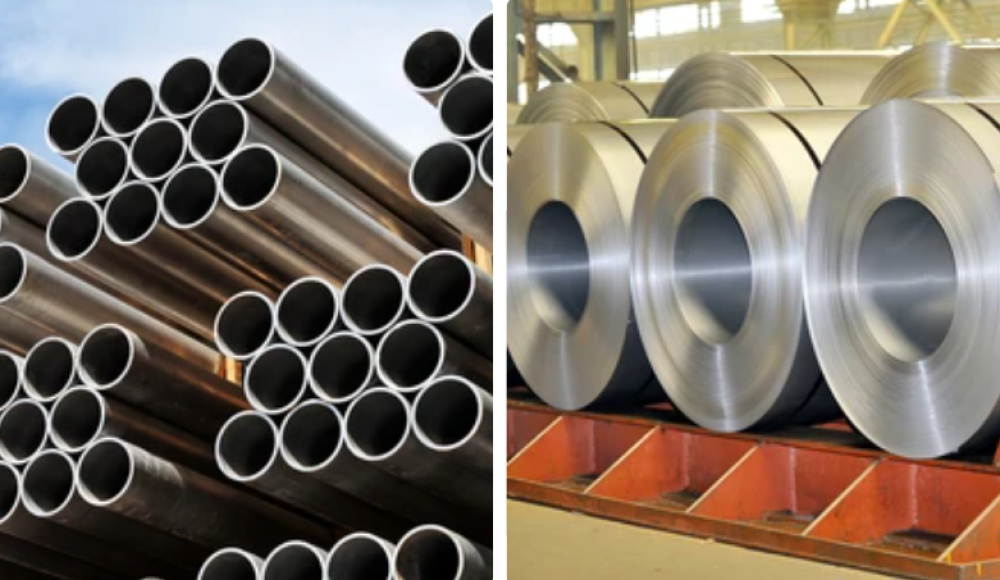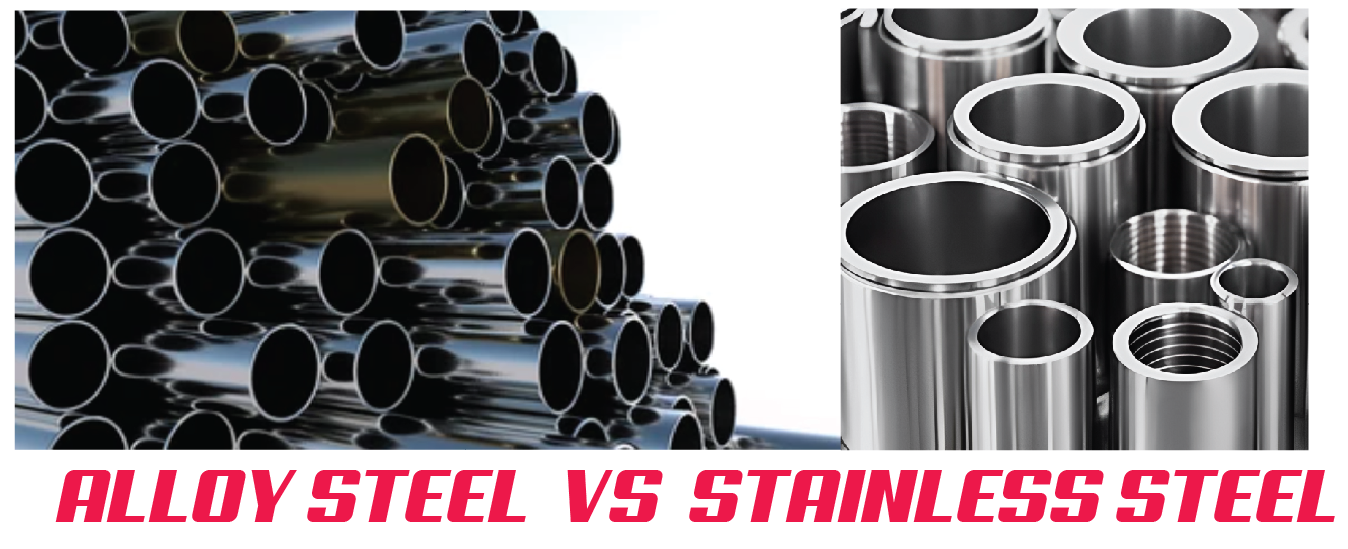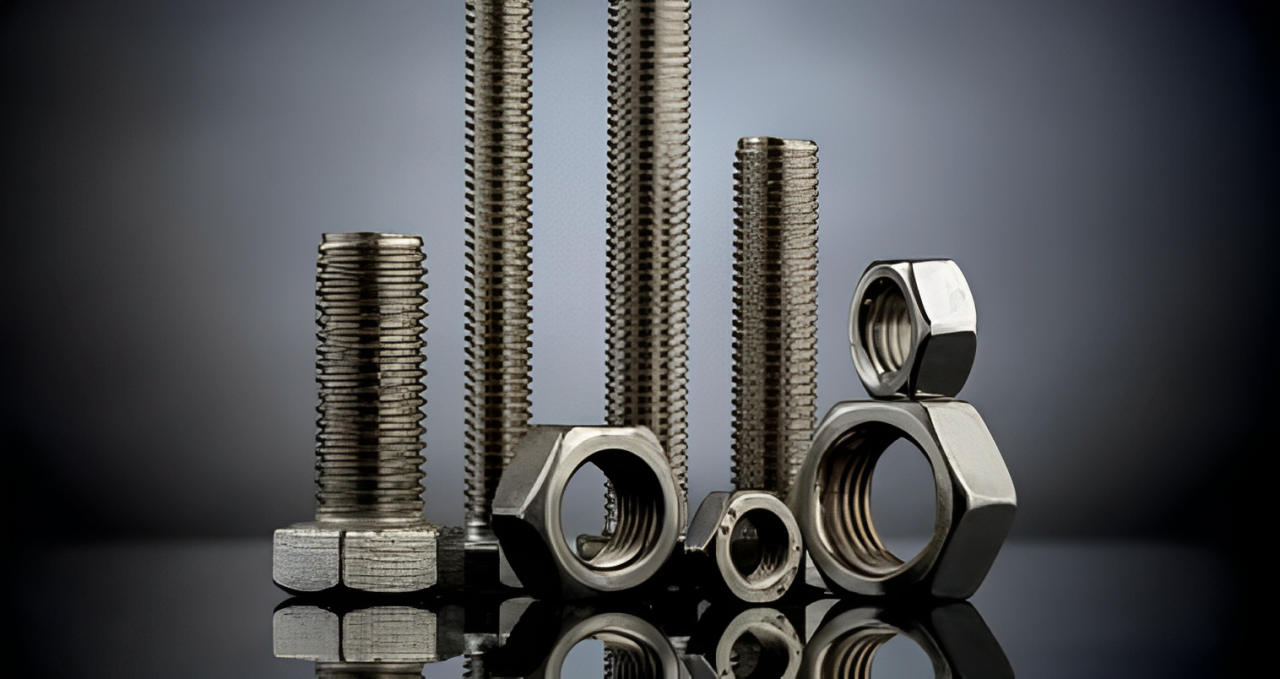As it is widely known acier plays a part in many industrial branches, for construction, different manufacturing, and automotive industry. The various types of steel grades available today include alloy steel and stainless steel among other products since these products are cataloged for uses because of their flexible characteristics and high levels of durability. But then each type of steel has unique features that qualify it for certain applications. Dans cet article, you will discover what alloy steel and stainless steel materials are, the differences of their kinds, and useful tips for deciding when to use each material for your parts production.
What is Alloy Steel?
L'acier allié fait référence à l'acier contenant un ou plusieurs éléments d'alliage., c'est à dire. manganèse, chrome, nickel, molybdène, vanadium, et du silicium. Les quantités de ces éléments sont généralement différentes et comprennent généralement entre un et cinquante pour cent.. En conséquence directe, il améliore les caractéristiques de résistance, maniabilité, dureté, corrosion, et porter. L'acier allié est utilisé dans les industries qui exigent de la résistance et des rendements élevés, notamment; aviation, automobiles, et secteurs mécaniques.
Qu'est-ce que l'acier inoxydable?
L'acier inoxydable est un matériau utilisé dans la construction car c'est un alliage d'acier contenant au moins 10, ou 5% chrome. Donc, it ensures outstanding corrosion protection through the Cr2O3 chromium oxide layer. It also has other ingredients including nickel, and molybdenum which also increase its capability of not contracting rust, staining, et corrosion. Donc, the most important qualities customers value are its appearance, sanitary properties, et la ténacité, which is why stainless steel is demanded in numerous branches. These may include the food industry, medical instruments production, construction, etc..
Types of Alloy Steel
Donc, here are the different forms of alloy steel and their compositions, propriétés, and uses in industries.
| Type of Alloy Steel | Explication | Propriétés clés | Applications typiques |
| Acier faiblement allié | Contient < 5% alloying elements | Improved mechanical properties | Applications structurelles, ponts, bâtiments |
| Acier hautement allié | Contient > 5% alloying elements | Superior hardness and wear resistance | High-performance applications, outils industriels |
| Acier chromoly | Chromium-molybdenum alloy | Haute résistance, résistance à la chaleur | Pièces aérospatiales, composants automobiles |
| Nickel Alloy Steel | Contains nickel for toughness | Excellent toughness at low temperatures | Cryogenic applications, récipients sous pression |
| Manganese Steel | Known for high-impact strength | Abrasion resistance | Wear parts (par exemple., rock crushers, railway tracks) |
Types d'acier inoxydable
Donc, let’s discuss the different types of stainless steel in the following table.
| Type of Stainless Steel | Explication | Propriétés clés | Applications typiques |
| Acier inoxydable austénitique | The most common type; is non-magnetic | Excellente résistance à la corrosion, formabilité | Équipement de cuisine, Équipement médical |
| Acier inoxydable ferritique | It contains chromium and a little nickel | Résistance à la corrosion modérée, good formability | Pièces automobiles, appareils électroménagers |
| Acier inoxydable martensitique | Contains higher carbon; known for hardness | High strength and hardness | Instruments chirurgicaux, outils de coupe |
| Acier inoxydable duplex | Combines austenitic and ferritic properties | Haute résistance, excellente résistance à la corrosion | Oil and gas industry, traitement chimique |
| Precipitation Hardening Stainless Steel | Strengthened by heat treatment | Exceptional strength | Composants aérospatiaux, outils hautes performances |
Comparison Between Alloy Steel vs. Acier inoxydable
Now and then we come across the terms Alloy Steel and Stainless Steel. Let’s discuss the major differences between them.
1. Résistance à la corrosion
Stainless steel is very immune to corrosion by the contents of chromium. It tends to form an oxide layer making it suitable for moisture or any other corrosiony environment. Cependant, for alloy steel to offer the same level of resistance it has to be put under treatment that is not inherently very resistant.
2. Force
Depending on the type of alloying elements used, we can improve the tensile strength in alloy steel for enhanced high performance. En outre, stainless steel has a higher strength than carbon steel and is not stronger than alloy steel.
3. Coût
Stainless steel is slightly more costly than alloy steel due to the use of chromium and nickel and the difficulty level when processing it. Par exemple, Alloy steel articles could be cheaper more often than not since they can employ cheaper alloying agents.
4. Esthétique
Rubber has excellent abrasion resistance is chemically resistant and is mostly used in stockings. Stainless steel has a shiny, polished look and is used where appearance can be important, c'est à dire. pole. Cependant, alloy steel is not visually appealing but more functional.
5. Propriétés magnétiques
Most stainless steels feel no magnetic attraction and are suitable for uses where magnetism is significant. Like most steels, many alloy sheets have what is known as ‘magnetic response’, which is sometimes desirable in industrial uses.
6. Durabilité
Alloy steel is developed to deal with high stress making it ever strong and durable under pressure. Most stainless steel offers good resistance against corrosion but their mechanical properties may not have high-strength alloy steels under high loads.
7. Résistance à la chaleur
In subsequent cases where thermal stress is an issue, stainless steel usually performs better as it does not lose shape under high temperatures. But depending on its formulation, we use alloy steel, specially developed for high-temperature strength.
8. Maniabilité
Alloy steel is easier to work with particularly when designing complex structures that may require sophisticated work. Acier inoxydable, even stronger, is also heavier and more difficult to work with due to its hardness. En plus, it has problems with electromagnetic work hardening.
| Characteristic | Acier allié | Acier inoxydable |
| Résistance à la corrosion | Requires special treatments; less resistant | Highly resistant due to chromium content |
| Force | Haute résistance à la traction (jusqu'à 250,000 psi) | Moderate strength (jusqu'à 200,000 psi) |
| Coût | Généralement plus abordable ($0.50 – $2.00/lb) | Plus cher ($1.50 – $4.00/lb) |
| Esthétique | More functional; generally matte finish | Prized for shiny, polished appearance |
| Propriétés magnétiques | Retains magnetic properties | Most grades are non-magnetic |
| Durabilité | Excellent under extreme stress | Durable against corrosion |
| Résistance à la chaleur | Varies based on composition; up to 1,200°F | Maintains integrity up to 1,500°F |
| Maniabilité | Easier to machine and fabricate | More challenging to weld and shape |
Conseils à prendre en compte lors du choix de l'acier idéal pour votre projet d'usinage
The following are important factors you consider while choosing the ideal steel for your project.
- Résistance à la corrosion: Choose stainless steel for areas exposed to water or chemicals.
- Résistance et durabilité: Choose the alloy steel if it is necessary to have high tensile strength and a certain level of toughness.
- Coût: Alloy steel costs are lower than those of stainless steel.
- Exigences esthétiques: Stainless steel should be used in projects where the final product requires some polished and aesthetically pleasing element.
- Usinabilité: Certain types of both materials may be more difficult to work with so the selection depends on what is desirable for a given project.
Applications de l'acier allié
Donc, here are some of the common applications of alloy steel:
- Composants automobiles: Popular for gear shafts and axles since it is a tough and strong material.
- Pièces aérospatiales: Suitable for aircraft landing gear and turbine blades because of their high-temperature properties.
- Construction: Employed in high-strength structural parts such as bridges and buildings.
- Outillage: Popular in drill bits, saws, and machine tools as a result of the hardness of this type of steel.
- Huile & Industrie du gaz: Applied in pipelines and pressure vessels for its high tensile strength and service at elevated temperatures.
Application de l'acier inoxydable
Donc, here are some of the common applications of stainless steel:
- Équipement médical: It is used where surgery instruments and implants are applied because of its ability to avoid corrosion and have hygienic properties.
- Transformation des aliments: Widespread in refrigerators, stoves, Ustensiles de cuisine, and food packaging because of its hygienic features.
- Construction: Applied in the construction of exterior elevations, toits, and balconies due to hardness and ornamental appearance.
- Automobile: Utilized in exhaust systems and trims, as it does not corrode.
- Traitement chimique: Applied to tanks, vannes, and pipes to deal with corrosion chemicals.
Avantages et inconvénients de l'acier allié
The following are the pros and cons of alloy steel:
Avantages:
- This material has a high strength-to-weight ratio means that it is safe and highly energy efficient.
- Superior toughness.
- Great versatility in its mechanical properties.
- Bonne résistance à l'usure.
- Usefulness in various applications in stress-bearing applications.
Limites:
- Must be coated or plated to protect against rusting and corrosion.
- It can be more formidable to parse using a machine.
- It is quite an expensive material than carbon steel.
- Prone to rusting if not well taken care of.
- Not as pleasing to the eye as stainless steel.
Avantages et inconvénients de l'acier inoxydable
Avantages:
- It offers significant corrosion resistance.
- Facile à nettoyer et à entretenir.
- Shiny finish to the attractively designed surfaces.
- Résistance aux hautes températures.
- Durable and long-lasting.
Limites:
- Costly than the alloy steel materials for item construction.
- Some grades are difficult to weld and machine.
- Vulnerable to stress corrosion cracking.
- Not stronger than alloy steel in some applications.
- More heavier than some types of steel.
Quand choisir l’acier allié?
- When your project calls for more strength and toughness.
- For those applications that are subjected to high temperature or heavy load conditions.
- When cost is an issue that cannot be overlooked and has to be kept to a minimum.
- When corrosion is not a major factor, or when such special treatments are possible.
- Parts that will experience fatigue and rubbing.
Quand choisir l’acier inoxydable?
- For applications, where the requirement is for high resistance to corrosive environment.
- When the look and cleanliness of the material matter.
- Ceramics depends much on its usage in areas where it comes in contact with chemicals or moisture.
- In projects where the longevity of the building is important.
- It is a smooth and nonmagnetic material, highly used in the product construction manufacturing.
Conclusion
En conclusion, the alloy steel vs. stainless offer several features and may be recommended for different uses. Alloy steel is used where stress is likely to be high. mis-à-part, it is significant for the strength and toughness of the material. Cependant, Stainless steel must be used in electrolytic applications where sleek appearance and hygiene are important as well as corrosion resistance. Evaluating these two materials and their differences gives you the right information. Donc, you can choose the best material for your project when selecting steel.
Questions fréquemment posées
1. What is the difference between alloy steel and stainless steel?
Alloy steel is famous for its high strength and toughness while stainless steel is well known for its resistance to corrosive attack.
2. What steel is more suitable for use at high temperatures?
Alloy steel is preferred where heat is involved since it has better heat-resistant properties than stainless steel.
3. Is stainless steel magnetic?
Martensitic stainless steel for example is magnetic while austenitic stainless steel is not.
4. Can alloy steel rust?
Oui, it is a fact that if alloy steel is not protected by proper corrosion–resistant coatings, then it can rust.
5. Is stainless steel more difficult to machine than alloy steel?
Stainless steel machining may be harder due to its extra inherent strength, although this depends on the steel grades.
6. Which steel is more costly alloy steel or stainless steel?
Stainless steel is more costly than regular carbon steel due to its more chromium and nickel composition.
7. For which industries are the products made of alloy steel suitable?
Alloy steel can be used in the aerospace, automobile, construction, and oil industries.











1 réfléchi à "Acier allié vs acier inoxydable: Un guide complet”